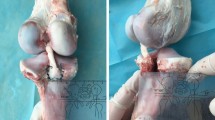Abstract
Purpose
Displaced tibial posterior cruciate ligament (PCL) avulsion fractures require surgical fixation in order to provide an adequate bone healing and to avoid a loss of posterior stability. The purpose of this study was to compare the biomechanical properties of a recently established modified suture bridge technique to a well-established transtibial pullout technique. It was hypothesized that the suture bridge technique shows lower elongation and higher load to failure force compared to a transtibial pullout fixation.
Methods
Twelve fresh-frozen human cadaveric knees were biomechanically tested using an uniaxial hydrodynamic material testing system. A standardized bony avulsion fracture of the tibial PCL insertion was generated. Two different techniques were used for fixation: (A) suture bridge configuration and (B) transtibial pullout fixation. In 90° of flexion elongation, initial stiffness and failure load were determined.
Results
The suture-bridge technique resulted in a significant lower elongation (4.5 ± 2.1 mm) than transtibial pullout technique (12.4 ± 3.0 mm, p < 0.001). The initial stiffness at the beginning of cyclic loading was 46.9 ± 3.9 N/mm in group A und 40.8 ± 9.0 N/mm in group B (p = 0.194). Load to failure testing exhibited 286.8 ± 88.3 N in group A and 234.3 ± 96.8 N in group B (p = 0.377).
Conclusion
The suture bridge technique provides a significant lower construct elongation during cyclic loading. But postoperative rehabilitation must respect the low construct strength of both techniques because both fixation techniques did not show a sufficient fixation strength to allow for a more aggressive rehabilitation.





Similar content being viewed by others
References
Chen W et al (2016) Treatment of posterior cruciate ligament avulsion fractures of the tibia using a toothed plate and hollow lag screw. Singap Med J 57(1):39–44
Domnick C et al (2016) Biomechanical properties of different fixation techniques for posterior cruciate ligament avulsion fractures. Arthroscopy 32(6):1065–1071
Gwinner C et al (2014) Arthroscopic treatment of acute tibial avulsion fracture of the posterior cruciate ligament using the TightRope fixation device. Arthrosc Tech 3(3):e377–e382
Hooper PO III et al (2018) Management of posterior cruciate ligament tibial avulsion injuries: a systematic review. Am J Sports Med 46(3):734–742
Inoue M et al (2004) Primary repair of posterior cruciate ligament avulsion fracture: the effect of occult injury in the midsubstance on postoperative instability. Am J Sports Med 32(5):1230–1237
Lee KW et al (2015) Suture bridge fixation technique for posterior cruciate ligament avulsion fracture. Clin Orthop Surg 7(4):505–508
Veselko M, Saciri V (2003) Posterior approach for arthroscopic reduction and antegrade fixation of avulsion fracture of the posterior cruciate ligament from the tibia with cannulated screw and washer. Arthroscopy 19(8):916–921
Zhao J, He Y, Wang J (2006) Arthroscopic treatment of acute tibial avulsion fracture of the posterior cruciate ligament with suture fixation technique through Y-shaped bone tunnels. Arthroscopy 22(2):172–181
Willinger L et al (2018) Fixation of bony avulsions of the posterior cruciate ligament by a suture-bridge technique. Oper Orthop Traumatol
Gwinner C et al (2016) All-arthroscopic treatment of tibial avulsion fractures of the posterior cruciate ligament. GMS Interdiscip Plast Reconstr Surg DGPW 5:Doc02. https://doi.org/10.3250/iprs000081
Nakagawa S et al (2017) Arthroscopic pullout fixation for a small and comminuted avulsion fracture of the posterior cruciate ligament from the Tibia. Knee Surg Relat Res 29(4):316–320
Yoon JR, Park CD, Lee DH (2018) Arthroscopic suture bridge fixation technique with multiple crossover ties for posterior cruciate ligament tibial avulsion fracture. Knee Surg Sports Traumatol Arthrosc 26(3):912–918
Zhang X et al (2013) A minimally invasive postero-medial approach with suture anchors for isolated tibial avulsion fracture of the posterior cruciate ligament. Knee 20(2):96–99
Frosch K et al (2012) Treatment of bony avulsions of the posterior cruciate ligament (PCL) by a minimally invasive dorsal approach. Oper Orthop Traumatol 24(4–5):348–353
Fox RJ et al (1998) Determination of the in situ forces in the human posterior cruciate ligament using robotic technology. A cadaveric study. Am J Sports Med 26(3):395–401
Griffith JF et al (2004) Cruciate ligament avulsion fractures. Arthroscopy 20(8):803–812
Pandey V et al (2017) Management of comminuted tibial end bony avulsion of posterior cruciate ligament by open posterior approach using suture bridge technique: a case series. J Clin Orthop Trauma 8(Suppl 2):S36–S39
Harner CD et al (1998) The effects of a popliteus muscle load on in situ forces in the posterior cruciate ligament and on knee kinematics. A human cadaveric study. Am J Sports Med 26(5):669–673
Pandy MG, Shelburne KB (1997) Dependence of cruciate-ligament loading on muscle forces and external load. J Biomech 30(10):1015–1024
Shelburne KB, Pandy MG (1997) A musculoskeletal model of the knee for evaluating ligament forces during isometric contractions. J Biomech 30(2):163–176
Yastrebov O, Lobenhoffer P (2010) Refixation of tibial bony avulsions of the posterior cruciate ligament with a hook plate. Oper Orthop Traumatol 22(4):347–353
Funding
There was no funding of the study.
Author information
Authors and Affiliations
Corresponding author
Ethics declarations
Conflict of interest
Andreas B. Imhoff is consultant for Arthrex, Arthrosurface and Medi. Andreas B. Imhoff receives royalties from Arthrex and Arthrosurface. The other authors declare that they have no conflict of interest.
Ethical approval
All specimens were obtained from MedCure, Portland/OR, USA for biomechanical testing. The use and removal of the specimen was in accordance to Medcure guidelines. An approval of the local ethics committee was not obtained for this biomechanical cadaver study.
Additional information
Publisher's Note
Springer Nature remains neutral with regard to jurisdictional claims in published maps and institutional affiliations.
Rights and permissions
About this article
Cite this article
Forkel, P., Lacheta, L., von Deimling, C. et al. Modified suture-bridge technique for tibial avulsion fractures of the posterior cruciate ligament: a biomechanical comparison. Arch Orthop Trauma Surg 140, 59–65 (2020). https://doi.org/10.1007/s00402-019-03278-5
Received:
Published:
Issue Date:
DOI: https://doi.org/10.1007/s00402-019-03278-5




